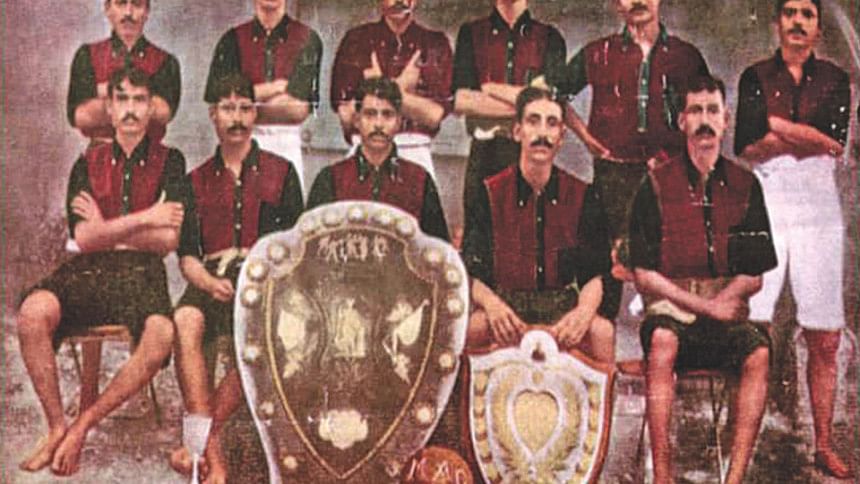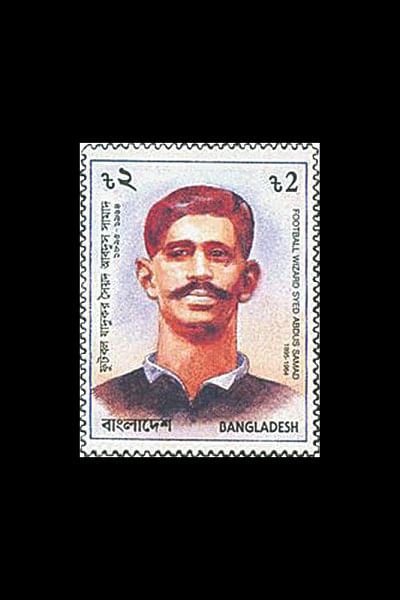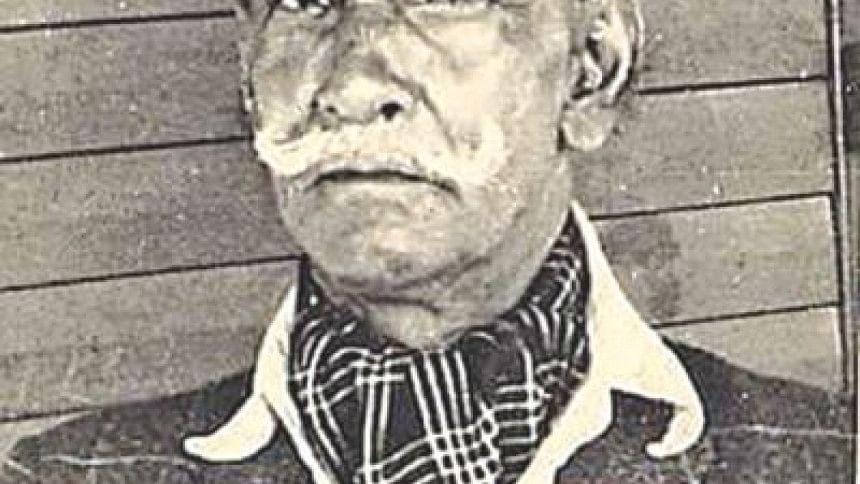Football and nationalisms in Bengal

Metaphors of "war" and "tribalism" have been invariably used in writings on football by observers ranging from eminent writers like Arthur Koestler and George Orwell to professional historians and media commentators of sports. The advent of the World Cup is typically announced in martial language: "Drums are beating", "trumpets are blowing", "flags are flying" (say of Argentina or Brazil—not only in these countries but among "warring partisan groups" in Bangladesh and other countries as well. It is not only Bangladeshis who suffer from "obsessions" and an "irrational dedication" in relation to alien nations' teams, as noted by one op-ed writer in The Daily Star recently, but people of many other nations tend to manifest similar behaviour), and so on. The football coach of Holland, in 1974, was even addressed as "the General."
More importantly, the game of football can also be seen as an arena of nationalist contestation. In fact, for Arthur Koestler, there is nationalism and there is football nationalism—the latter is much more deeply felt. As famous historian Eric Hobsbawm put it aptly, "the imagined community [a scholarly jargon indicating nationalism] of millions seems more real as team of eleven named people." But beyond jingoistic or chauvinistic expressions, the game of football can be and has been a manifestation of what I would like to call empowering nationalist ideology, especially for the subaltern (of de facto lower ranks—socially, culturally and politically) communities engaged in an adversarial struggle, culturally, ideologically and politically, vis-à-vis dominant/hegemonic communities. Such an empowering syndrome was manifestly demonstrated in the arenas of football in colonial Bengal.
Football in colonial Bengal
The grand beginning: which Indian first kicked the football?
The credit goes to a Bengali named Nagendraprasad Sarbadhikari who did it in 1879 (trust me I am not trying to be a Bengali chauvinist here, it is just a fact from the recorded history of Indian football). The story goes like this: he was 11 years old and was going to bathe in the Ganga with his mother. While crossing the Maidan (in Kolkata) they saw a few English soldiers kicking a round-shaped object. He became curious and got down from the horse carriage to watch. By divine providence the object landed near his feet. He picked it up and found it very light. A soldier shouted at him to kick it back and he duly obliged. A History was created. Later this boy would become one of the major promoters of football and a pioneer in establishing clubs, institutionalising rules and regulations of the game, and organising principles of football clubs in Bengal (in the 1880s and 1890s).
Football as an English colonial project of disciplining natives and the cunning of history
A major reason for English colonialists to patronise football among Bengalis was to instil a "games ethic" among the local populace so that they could to be more like moral Christians. The ethics represented "muscular Christianity" embodying hard work, physical development (the Brits emphasised developing "manliness" since Bengalis were stereotyped by them as an effeminate non-military race), perseverance, team loyalty, and obedience to authority. But the cunning of history was such that Bengalis learned the sports and instead of mimicking the colonial masters they reformulated the imperial game ethic and started competing with the coloniser on an equal plane. Football became a hot site for identity politics and cultural assertion, resistance, subversion as well as for the demand for political freedom. When Mohun Bagan won the 1911 Indian Football Association (IFA) Shield defeating an English military team, an elderly sanyasi (monk) asked one of the team members: "we are thrilled that you have overcome the military team, but when will you pull that down?" He was pointing towards the British flag fluttering over Fort William. The player replied: "The next time we beat the English on the football pitch." Interestingly, the next time Mohun Bagan won the IFA Shield was 1947.
Of boots and Bengali men
Throughout the colonial era, local footballers played barefooted against the booted English. It was, to a large extent, by choice. One consideration was being barefooted and playing with booted rivals added to manliness—one's ability to prevail over technologically equipped opponents by the utter bravery, skills and intelligence, stealing the ball with a nimble flip of the toes and so on. The football legend Samad (of Mohammedan Sporting Club) who became a mythical hero for his barefooted dribbling skills in the 1920s and 1930s went to see a match in the Maidan in 1962 (from Dhaka, where he migrated after 1947) where all players were wearing boots (due to new regulations). When asked about the standard of the game he said: "It wasn't a bad game, but it could just easily have been played by women."

Historian Partha Chatterjee noted that there was indeed an aura of Oriental magic in relation to Indian players playing barefooted. When an Indian team visited Australia in 1938 their feet were closely examined and photographed and pictures were published in the newspapers. But there was a great disadvantage of being barefooted. When it rained the field became slippery and made it difficult for barefooted players to manoeuvre and dribble efficiently, which did not create problems for the booted ones (almost all games were played during the monsoon season during the colonial era). To avoid the disadvantages of consequent asymmetric duel, the smart Secretary of the Mohammedan club, S A Aziz, came up with an ingenious solution. He worked with the cobblers of the Fort William to design a boot which was light and flexible. When there was no rain the players would play barefoot with the boots reserved on the sidelines and as soon as the rain started the players would don the boots (the boots being flexible preserved some advantages of the nimble toes). This strategy (exclusive to Mohammedan) worked miracles, thereby enhancing the performance of the club considerably.

Football, empowering nationalism and subaltern resistance
First phase of football nationalism—one club, one nationalism
Although several Indian clubs played football during the last two decades of the 19th and the first two decades of the 20th centuries, it was Mohun Bagan that was the centre of the universe and icon of anti-colonial resistance. Established in 1889 its main aim was to reformulate the colonial game ethics (physical and mental/personality development) in the natives' favour (which they did successfully) but little did the pioneers foresee that with the epic victory of IFA Shield in 1911, the club would be transformed into an epicentre of national awakening. One should note that the victory came right after the pre-dominantly elite Hindu-led movement of 1905–08 against the partition (Banga Bhanga), which primed the cultural and ideological environment for such an awakening. As football historian Kausik Bandyopadhyay observed: "[after the Banga Bhanga movement] …Bengali looked towards the game with a new purpose. Any success against British teams on the football field began to be viewed as a victory of the spirit of nationalism over the evil of colonialism." Also any possible victory by the Bengalis (of IFA Shield) was deemed to be historically of so much significance that (almost in a clash of civilization sense) one executive (Mr. Watson) of an exclusively British club remarked (in 1892 or 1893) in an annual club dinner that "If the Bengalees ever win this trophy—defeating all European teams—they may well claim to have wiped off the stain of the field of Plassey." Coincidentally, it was in 1911 when British Raj decided to shift the capital from Kolkata to Delhi. Many historians find deeper connections between this decision and Mohun Bagan's victory. As eminent historian Ramachandra Guha puts it in a most dramatic manner: "…to pre-empt further humiliation the British adroitly and deliberately moved the seat of power from Bengal, away from its skilful footballers and its bomb-wielding nationalists."

That this victory of Mohun Bagan was considered as the high point of Bengali anti-colonial nationalism points to the prevailing historical reality of "one club, one nationalism." To put it in a more nuanced theoretical-historical fashion, it was a classic stage of the history of Bengal nationalism whereby the "nation" (whose prevailing dominant vision/ideology de facto was determined only by the elite hegemonic groups and classes) and its "fragments" (non-dominant/subaltern groups and classes—peasants, women, minority religious and ethnic groups etc.) purportedly worked in unison. This was indeed the case with the 1911 event. The victory was equally celebrated by all groups, by Hindus and Muslims. To put it in contemporary social science parlance, Muslims felt "ownership" over Mohun Bagan's success and the nationalist pride that came along with it. Contemporary observations indeed attest to this fact. The newspaper Mussalman reported: "[the members of Mohammedan Sporting] were almost mad and rolling on the ground with joyous excitement on the victory of their Hindu brethren." The Muslim Journal Comrade remarked: "We hereby join the chorus of praise and jubilation over the splendid victory of Mohun Bagan."
Second phase—unitary hegemonic nationalism challenged
The game of football could not hold on to this unity of the nation and its fragments for long. The reasons, for our purpose, are essentially two folds: the rise of Bengali Muslim nationalist politics in the decades of 1920s and 1930s and the dazzling success of Mohammedan football club in the mid-1930s. From mid 1930s onward, rivalry in football (as a proxy for nationalist contestations) was no longer limited to the English (the colonial elite) versus the Bengalis (colonised subaltern) but extended to rivalry between Hindus versus Muslims or to put it in our analytical parlance, between the hegemonic nation (the Hindu elites) and the subaltern fragment (the doubly subjugated Muslims—both by the English and the Hindu elites).

The dazzling success of the Mohammedan club, mentioned above, was the successive five times victories (between 1934 and 1938) of the club against British teams, in a much more prestigious competition, the Calcutta Football League. Most incredibly the club became champion when it was just promoted from second to first division and was called the shishu (baby) team. The joyous reactions to such a footballing achievement among the Bengali Muslims—who were lacking in confidence due to their disadvantaged position in social and cultural spheres and experiencing political marginalisation—was overwhelming. It acted as an enormous morale booster for the community. The Mayor of Kolkata, A K Fazlul Haque (Sher-e-Bangla) paid tribute: "The marvellous achievements of the Mohammedan Sporting Club on the football field have earned a name and fame for Muslims in the sporting world, of which the community may justly be proud."
Poet Kazi Nazrul was so enthused by the anti-colonial nationalist aspiration embedded in football that he felt to compare football with the freedom itself:
Ay dike 'rajot', o dike 'naraji' dal
Center-e pore ache 'Bharater shadhinota' football!
He also wrote a famous poem ("Mobarakbad") congratulating the Mohammedan club on its victory that brought solace to his "nirashabadi" (pessimist) country:
Ay Bharater obonoto shire tomra porale taj,
Shujog paile,shoktite mora ojeo, dykhale aaj
Eki obhinobo kirti rakhile nirashabadir deshe,
Adhar gogone ashar Eid-er chand uthilo je heshe!
Poet Golam Mostafa wrote a poem "League Bijoy", the most popular two lines of which, comparing winning the league with conquering the horizon, were:
Noire ae league bijoy,
Ajke moder deeg bijoy.
This poem was converted into a song sung by legendary singer Abbas Uddin. This song became an instant hit throughout Bengal and Assam. Sher-e-Bangla Fazlul Haque once remarked that if someone gave him poet Nazrul, singer Abbas Uddin and Mohammedan Club together, he will be able to conquer the entire Bengal. The Muslim Bengali reawakening due to Mohammedan's success, not surprisingly, created some consternation among some elite Hindus. As historian Kausik Bandyopadhyay remarked: "For some, a section of Hindus to be particular, however, the development was of concern as it represented a victory of Muslim confidence and superiority." Even now, in mainstream and popular historical accounts of sports and nationalism in India, it is the Mohun Bagan's victory of the IFA Shield of 1911 which is considered as a greater nationalistic achievement than Mohammedan's five straight wins in the Calcutta Football League. The hurt ego of some elites still lingers.
Mirza Hassan is a researcher. His research focuses on the political economy of development and social change. He can be reached [email protected].





Comments